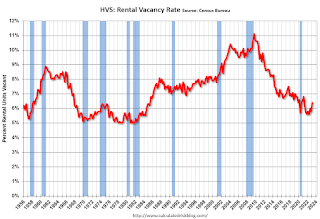by Calculated Risk on 5/07/2023 09:32:00 AM
Sunday, May 07, 2023
Realtor.com Reports Weekly Active Inventory Up 35% YoY; New Listings Down 22% YoY
Realtor.com has monthly and weekly data on the existing home market. Here is their weekly report from chief economist Danielle Hale: Weekly Housing Trends View — Data Week Ending Apr 29, 2023
• Active inventory was up at a slower pace, with for-sale homes up just 35% above one year ago. The number of homes for sale continues to grow, but compared to one year ago, the pace is slowing.
...
• New listings–a measure of sellers putting homes up for sale–were down again this week, by 22% from one year ago. The number of newly listed homes has been lower than the same time the previous year for the past 43 weeks.
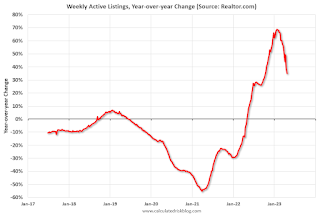 Here is a graph of the year-over-year change in inventory according to realtor.com.
Here is a graph of the year-over-year change in inventory according to realtor.com. Inventory is still up year-over-year - from record lows - however, the YoY increase has slowed sharply recently.
Saturday, May 06, 2023
Real Estate Newsletter Articles this Week: Year-over-year Rent Growth Continues to Decelerate
by Calculated Risk on 5/06/2023 02:11:00 PM
At the Calculated Risk Real Estate Newsletter this week:
• Year-over-year Rent Growth Continues to Decelerate
• Lawler: Invitation Homes Net Seller of Single-Family Properties for Second Straight Quarter
• A Policy Proposal to Increase the Utilization of the Current Housing Stock
• Black Knight Mortgage Monitor: Home Prices Increased in March; Prices Up 1.0% YoY
• Early Look at Local Housing Markets in April
This is usually published 4 to 6 times a week and provides more in-depth analysis of the housing market.
You can subscribe at https://calculatedrisk.substack.com/
Most content is available for free (and no Ads), but please subscribe!
Schedule for Week of May 7, 2023
by Calculated Risk on 5/06/2023 08:11:00 AM
The key report this week is April CPI.
Note: The Fed will release the Senior Loan Officer Opinion Survey on Bank Lending Practices (SLOOS) on Monday. This will provide some information on recent credit tightening.
2:00 PM: Senior Loan Officer Opinion Survey on Bank Lending Practices for April.
6:00 AM ET: NFIB Small Business Optimism Index for April.
7:00 AM ET: The Mortgage Bankers Association (MBA) will release the results for the mortgage purchase applications index.
8:30 AM: The Consumer Price Index for April from the BLS. The consensus is for 0.4% increase in CPI (up 5.0% YoY), and a 0.3% increase in core CPI (up 5.5% YoY).
8:30 AM: The initial weekly unemployment claims report will be released. The consensus is for 250 thousand initial claims, up from 242 thousand last week.
8:30 AM: The Producer Price Index for April from the BLS. The consensus is for a 0.3% increase in PPI, and a 0.3% increase in core PPI.
10:00 AM: University of Michigan's Consumer sentiment index (Preliminary for May).
Friday, May 05, 2023
COVID May 5, 2023, Update: New Pandemic Low for Hospitalizations
by Calculated Risk on 5/05/2023 09:04:00 PM
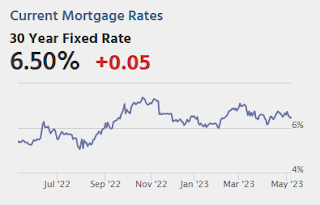
| COVID Metrics | ||||
|---|---|---|---|---|
| Now | Week Ago | Goal | ||
| New Cases per Week2 | 77,924 | 90,318 | ≤35,0001 | |
| Hospitalized2 | 8,861 | 10,214 | ≤3,0001 | |
| Deaths per Week2🚩 | 1,109 | 1,049 | ≤3501 | |
| 1my goals to stop weekly posts, 2Weekly for Cases, Currently Hospitalized, and Deaths 🚩 Increasing number weekly for Cases, Hospitalized, and Deaths ✅ Goal met. | ||||
 Click on graph for larger image.
Click on graph for larger image.This graph shows the weekly (columns) number of deaths reported.
AAR: April Rail Carloads Increased, Intermodal Decreased Year-over-year
by Calculated Risk on 5/05/2023 03:01:00 PM
From the Association of American Railroads (AAR) Rail Time Indicators. Graphs and excerpts reprinted with permission.
Rail intermodal continues to struggle. U.S. intermodal volume was 12.7% lower in April 2023 than in April 2022. April’s decline was the 14th straight and 20th in the past 21 months. In 2023 through April, volume was 3.97 million containers and trailers, down 10.9% (484,228) from last year and the fewest for January to April since 2012. Year-to-date container volume was down 9.5%; trailer volume was down 28.3%. Trailers accounted for 5.8% of intermodal units In the first four months of 2023, a record low.
Meanwhile, carloads were better: total originated carloads on U.S. railroads in April were up 1.8% over April 2022 and averaged 234,159 per week — the most in six months. Year-to-date total carloads were 3.93 million, up 0.6% over the first four months of 2022 and the most for January to April since 2019.
emphasis added
 Click on graph for larger image.
Click on graph for larger image.This graph from the Rail Time Indicators report shows the six-week average of U.S. Carloads in 2021, 2022 and 2022:
Originated carloads on U.S. railroads in April 2023 totaled 936,637, up 1.8% over April 2022. Total carloads averaged 234,159 per week in April 2023, the most in six months.
For the first four months of 2023, total carloads were 3.93 million, up 0.6% (23,161 carloads) over the first four months of 2022 and the most for January to April since 2019.
 The second graph shows the six-week average (not monthly) of U.S. intermodal in 2021, 2022 and 2023: (using intermodal or shipping containers):
The second graph shows the six-week average (not monthly) of U.S. intermodal in 2021, 2022 and 2023: (using intermodal or shipping containers):U.S. railroads originated 945,313 intermodal containers and trailers in April 2023, down 12.7% (137,879 units) from April 2022. April’s decline was the 14th straight for intermodal. Originations averaged 236,328 units per week in April 2023, the most in five months.
In 2023 through April, intermodal volume was 3.97 million units, down 10.9% (484,228) from last year and the fewest for January to April since 2012.
Wholesale Used Car Prices Decreased in April; Down 4.4% Year-over-year
by Calculated Risk on 5/05/2023 01:46:00 PM
From Manheim Consulting today: Wholesale Used-Vehicle Prices See Sizable Decline in April
Wholesale used-vehicle prices (on a mix, mileage, and seasonally adjusted basis) decreased 3.0% in April from March. The Manheim Used Vehicle Value Index (MUVVI) dropped to 230.8, down 4.4% from a year ago.
“While values increased 8.6% through the first quarter from December, the market has reversed course in April, with our monthly figures showing a month-over-month decline for the first time in 2023,” said Chris Frey, senior manager of Economic and Industry Insights for Cox Automotive. “Values in April also continue to be lower year over year. We’ve experienced eight straight months of year-over-year declines, averaging 8.3%, and it’s likely not over yet. During the financial crisis, we had 16 months of annualized declines, averaging 5.8%. Though I’m not predicting doom, we’ve surely started a second, and more rapid, decent off the pandemic peak of January 2022.”
emphasis added
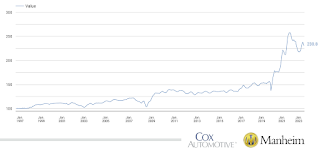 Click on graph for larger image.
Click on graph for larger image.This index from Manheim Consulting is based on all completed sales transactions at Manheim’s U.S. auctions.
Early Look at Local Housing Markets in April
by Calculated Risk on 5/05/2023 10:36:00 AM
Today, in the Calculated Risk Real Estate Newsletter: Early Look at Local Housing Markets in April
A brief excerpt:
This is a look at a few early reporting local markets in April. I’m tracking about 40 local housing markets in the US. Some of the 40 markets are states, and some are metropolitan areas. I’ll update these tables throughout the month as additional data is released.There is much more in the article. You can subscribe at https://calculatedrisk.substack.com/
Closed sales in April were mostly for contracts signed in February and March. Since 30-year fixed mortgage rates were over 6% for all of February and March - compared to the 4% range the previous year - closed sales were down significantly year-over-year in April.
It is likely sales were down more year-over-year in April than in March, however, the impact was probably not as severe as for closed sales in December and January (rates were the highest in October and November 2022 when contracts were signed for closing in December and January).
...
In April, sales in these markets were down 34.5%. In March, these same markets were down 26.5% YoY Not Seasonally Adjusted (NSA).
This is a larger YoY decline NSA than in March for these early reporting markets, however there was one less selling day in April this year. This early data suggests the April existing home sales report will show another significant YoY decline, and the 20th consecutive month with a YoY decline in sales.
This was a just a few early reporting markets. Many more local markets to come!
Comments on April Employment Report
by Calculated Risk on 5/05/2023 09:23:00 AM
The headline jobs number in the April employment report was above expectations, however employment for the previous two months was revised down by 149,000, combined. The participation rate and employment population ratio were unchanged, and the unemployment rate decreased to 3.4%.
In April, the year-over-year employment change was 4.00 million jobs.
Prime (25 to 54 Years Old) Participation
 Since the overall participation rate is impacted by both cyclical (recession) and demographic (aging population, younger people staying in school) reasons, here is the employment-population ratio for the key working age group: 25 to 54 years old.
Since the overall participation rate is impacted by both cyclical (recession) and demographic (aging population, younger people staying in school) reasons, here is the employment-population ratio for the key working age group: 25 to 54 years old.The 25 to 54 participation rate was increased in April to 83.3% from 83.1% in March, and the 25 to 54 employment population ratio increased to 80.8% from 80.7% the previous month.
Average Hourly Wages
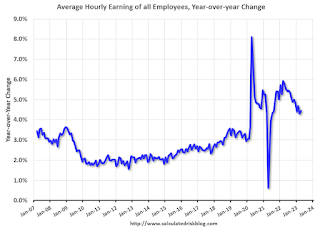 The graph shows the nominal year-over-year change in "Average Hourly Earnings" for all private employees from the Current Employment Statistics (CES).
The graph shows the nominal year-over-year change in "Average Hourly Earnings" for all private employees from the Current Employment Statistics (CES). Wage growth has trended down after peaking at 5.9% YoY in March 2022 and was at 4.4% YoY in April.
Part Time for Economic Reasons
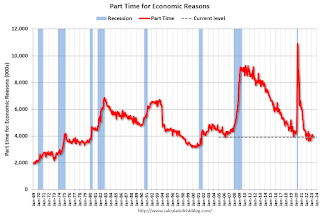 From the BLS report:
From the BLS report:"The number of persons employed part time for economic reasons, at 3.9 million, was little changed in April. These individuals, who would have preferred full-time employment, were working part time because their hours had been reduced or they were unable to find full-time jobs."The number of persons working part time for economic reasons decreased in April to 3.903 million from 4.102 million in March. This is below pre-recession levels.
These workers are included in the alternate measure of labor underutilization (U-6) that decreased to 6.6% from 6.7% in the previous month. This is down from the record high in April 22.9% and up slightly from the lowest level on record (seasonally adjusted) in December 2022 (6.5%). (This series started in 1994). This measure is below the level in February 2020 (pre-pandemic).
Unemployed over 26 Weeks
 This graph shows the number of workers unemployed for 27 weeks or more.
This graph shows the number of workers unemployed for 27 weeks or more. According to the BLS, there are 1.156 million workers who have been unemployed for more than 26 weeks and still want a job, up from 1.104 million the previous month.
This is at pre-pandemic levels.
Summary:
The headline monthly jobs number was above expectations; however, employment for the previous two months was revised down by 149,000, combined. The headline unemployment rate decreased to 3.4% - the lowest in over 50 years!
April Employment Report: 253 thousand Jobs, 3.4% Unemployment Rate
by Calculated Risk on 5/05/2023 08:44:00 AM
From the BLS:
Total nonfarm payroll employment rose by 253,000 in April, and the unemployment rate changed little at 3.4 percent, the U.S. Bureau of Labor Statistics reported today. Employment continued to trend up in professional and business services, health care, leisure and hospitality, and social assistance.
...
The change in total nonfarm payroll employment for February was revised down by 78,000, from +326,000 to +248,000, and the change for March was revised down by 71,000, from +236,000 to +165,000. With these revisions, employment in February and March combined is 149,000 lower than previously reported.
emphasis added
 Click on graph for larger image.
Click on graph for larger image.The first graph shows the jobs added per month since January 2021.
Payrolls for February and January were revised down 149 thousand, combined.
 The second graph shows the year-over-year change in total non-farm employment since 1968.
The second graph shows the year-over-year change in total non-farm employment since 1968.In April, the year-over-year change was 4.00 million jobs. Employment was up significantly year-over-year.
The third graph shows the employment population ratio and the participation rate.
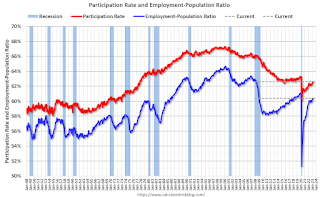 The Labor Force Participation Rate was unchanged at 62.6% in April, from 62.6% in March. This is the percentage of the working age population in the labor force.
The Labor Force Participation Rate was unchanged at 62.6% in April, from 62.6% in March. This is the percentage of the working age population in the labor force. The Employment-Population ratio was unchanged at 60.4% from 60.4% (blue line).
I'll post the 25 to 54 age group employment-population ratio graph later.
 The fourth graph shows the unemployment rate.
The fourth graph shows the unemployment rate. The unemployment rate decreased in April to 3.4% from 3.5% in March.
This was above consensus expectations; however, February and March payrolls were revised down by 149,000 combined.
Thursday, May 04, 2023
Friday: April Employment Report
by Calculated Risk on 5/04/2023 09:11:00 PM
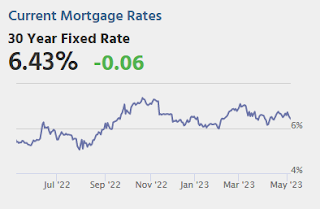
Friday:
• At 8:30 AM: Employment Report for April. The consensus is for 178,000 jobs added, and for the unemployment rate to increase to 3.6%.
Goldman April Payrolls Preview
by Calculated Risk on 5/04/2023 04:53:00 PM
A few brief excerpts from a note by Goldman Sachs economist Spencer Hill:
We estimate nonfarm payrolls rose 250k in April (mom sa), above consensus of +182k but a slowdown from the +345k average pace of the last three months. We believe high but falling labor demand more than offset continued layoffs in the information and financial sectors and a roughly 25k hiring drag from reduced credit availability. ... We estimate the unemployment rate was unchanged at 3.5% (vs. consensus 3.6%), reflecting a modest rise in household employment and unchanged labor force participation (at 62.6%).
emphasis added
Hotels: Occupancy Rate Up 0.1% Year-over-year
by Calculated Risk on 5/04/2023 02:59:00 PM
U.S. hotel performance showed mixed results from the previous week but remained up year over year, according to STR‘s latest data through April 29.The following graph shows the seasonal pattern for the hotel occupancy rate using the four-week average.
April 23-29, 2023 (percentage change from comparable week in 2022):
• Occupancy: 66.6% (+0.1%)
• Average daily rate (ADR): $156.14 (+5.5%)
• Revenue per available room (RevPAR): $104.01 (+5.6%)
emphasis added
 Click on graph for larger image.
Click on graph for larger image.The red line is for 2023, black is 2020, blue is the median, and dashed light blue is for 2022. Dashed purple is for 2018, the record year for hotel occupancy.
April Employment Preview
by Calculated Risk on 5/04/2023 12:50:00 PM
On Friday at 8:30 AM ET, the BLS will release the employment report for April. The consensus is for 178,000 jobs added, and for the unemployment rate to increase to 3.6%.
From BofA economists:
"For the April employment report, we expect the data to show a moderation from red-hot hiring to strong hiring. We forecast nonfarm payroll growth of 200k. While this would signal that the pace of hiring is cooling, it would still mean hiring is exceeding the level needed to offset population growth (roughly 70k to 100k). Moreover, we look for the unemployment rate to remain unchanged at an astoundingly low level of 3.5%."From Goldman Sachs following the strong ADP report:
"We boosted our nonfarm payroll forecast by 25k to +250k (mom sa)."• ADP Report: The ADP employment report showed 296,000 private sector jobs were added in April. This suggests job gains well above consensus expectations, however, in general, ADP hasn't been very useful in forecasting the BLS report.
• ISM Surveys: Note that the ISM services are diffusion indexes based on the number of firms hiring (not the number of hires). The ISM® manufacturing employment index increased in April to 50.2%, up from 46.9% last month. This would suggest about 20,000 jobs lost in manufacturing. The ADP report indicated 38,000 manufacturing jobs lost in April.
The ISM® services employment index decreased in April to 50.8%, from 51.3% last month. This would suggest service employment increased 95,000 in April.
Combined, the ISM surveys suggest 75,000 jobs added in April (well below the consensus forecast).
• Unemployment Claims: The weekly claims report showed essentially no change in the number of initial unemployment claims during the reference week (includes the 12th of the month) from 247,000 in March to 245,000 in April. There has been a general increase in unemployment claims suggesting more layoffs recently.
Trade Deficit decreased to $64.2 Billion in March
by Calculated Risk on 5/04/2023 08:48:00 AM
The Census Bureau and the Bureau of Economic Analysis reported:
The U.S. Census Bureau and the U.S. Bureau of Economic Analysis announced today that the goods and services deficit was $64.2 billion in March, down $6.4 billion from $70.6 billion in February, revised.
March exports were $256.2 billion, $5.3 billion more than February exports. March imports were $320.4 billion, $1.1 billion less than February imports.
emphasis added
 Click on graph for larger image.
Click on graph for larger image.Exports increased and imports decreased in March.
Exports are up 5% year-over-year; imports are down 9% year-over-year.
Both imports and exports decreased sharply due to COVID-19 and then bounced back - but imports have been decreasing recently.
The second graph shows the U.S. trade deficit, with and without petroleum.
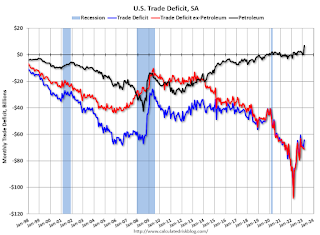 The blue line is the total deficit, and the black line is the petroleum deficit, and the red line is the trade deficit ex-petroleum products.
The blue line is the total deficit, and the black line is the petroleum deficit, and the red line is the trade deficit ex-petroleum products.Note that net, exports of petroleum products are positive and have picked up.
The trade deficit with China decreased to $16.6 billion in March, from $34.0 billion a year ago.
Weekly Initial Unemployment Claims increase to 242,000
by Calculated Risk on 5/04/2023 08:30:00 AM
The DOL reported:
In the week ending April 29, the advance figure for seasonally adjusted initial claims was 242,000, an increase of 13,000 from the previous week's revised level. The previous week's level was revised down by 1,000 from 230,000 to 229,000. The 4-week moving average was 239,250, an increase of 3,500 from the previous week's revised average. The previous week's average was revised down by 250 from 236,000 to 235,750.The following graph shows the 4-week moving average of weekly claims since 1971.
emphasis added
 Click on graph for larger image.
Click on graph for larger image.The dashed line on the graph is the current 4-week average. The four-week average of weekly unemployment claims increased to 239,250.
The previous week was revised down.
Weekly claims were close to the consensus forecast.
Wednesday, May 03, 2023
Thursday: Unemployment Claims, Trade Balance
by Calculated Risk on 5/03/2023 09:01:00 PM

Thursday:
• At 8:30 AM ET, The initial weekly unemployment claims report will be released. The consensus is for 243 thousand initial claims, up from 230 thousand last week.
• At 8:30 AM, Trade Balance report for March from the Census Bureau. The consensus is the trade deficit to be $63.8 billion. The U.S. trade deficit was at $70.3 billion in February.
Heavy Truck Sales Up Sharply Year-over-year in April
by Calculated Risk on 5/03/2023 03:53:00 PM
This graph shows heavy truck sales since 1967 using data from the BEA. The dashed line is the April 2023 seasonally adjusted annual sales rate (SAAR).
Heavy truck sales really collapsed during the great recession, falling to a low of 180 thousand SAAR in May 2009. Then heavy truck sales increased to a new all-time high of 570 thousand SAAR in April 2019.
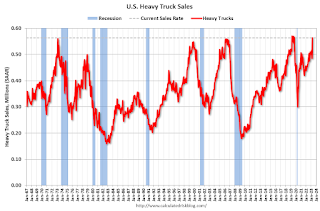 Click on graph for larger image.
Click on graph for larger image.Note: "Heavy trucks - trucks more than 14,000 pounds gross vehicle weight."
Heavy truck sales declined sharply at the beginning of the pandemic, falling to a low of 308 thousand SAAR in May 2020.
FOMC Statement: Raise Rates 25 bp; Pause in June Likely
by Calculated Risk on 5/03/2023 02:02:00 PM
Fed Chair Powell press conference video here or on YouTube here, starting at 2:30 PM ET.
FOMC Statement:
Economic activity expanded at a modest pace in the first quarter. Job gains have been robust in recent months, and the unemployment rate has remained low. Inflation remains elevated.
The U.S. banking system is sound and resilient. Tighter credit conditions for households and businesses are likely to weigh on economic activity, hiring, and inflation. The extent of these effects remains uncertain. The Committee remains highly attentive to inflation risks.
The Committee seeks to achieve maximum employment and inflation at the rate of 2 percent over the longer run. In support of these goals, the Committee decided to raise the target range for the federal funds rate to 5 to 5-1/4 percent. The Committee will closely monitor incoming information and assess the implications for monetary policy. In determining the extent to which additional policy firming may be appropriate to return inflation to 2 percent over time, the Committee will take into account the cumulative tightening of monetary policy, the lags with which monetary policy affects economic activity and inflation, and economic and financial developments. In addition, the Committee will continue reducing its holdings of Treasury securities and agency debt and agency mortgage-backed securities, as described in its previously announced plans. The Committee is strongly committed to returning inflation to its 2 percent objective.
In assessing the appropriate stance of monetary policy, the Committee will continue to monitor the implications of incoming information for the economic outlook. The Committee would be prepared to adjust the stance of monetary policy as appropriate if risks emerge that could impede the attainment of the Committee's goals. The Committee's assessments will take into account a wide range of information, including readings on labor market conditions, inflation pressures and inflation expectations, and financial and international developments.
Voting for the monetary policy action were Jerome H. Powell, Chair; John C. Williams, Vice Chair; Michael S. Barr; Michelle W. Bowman; Lisa D. Cook; Austan D. Goolsbee; Patrick Harker; Philip N. Jefferson; Neel Kashkari; Lorie K. Logan; and Christopher J. Waller.
emphasis added
Black Knight Mortgage Monitor: Home Prices Increased in March; Prices Up 1.0% YoY
by Calculated Risk on 5/03/2023 10:57:00 AM
Today, in the Calculated Risk Real Estate Newsletter: Black Knight Mortgage Monitor: Home Prices Increased in March; Prices Up 1.0% YoY
A brief excerpt:
Here is a graph of the Black Knight HPI. The index is still up 1.0% year-over-year and will likely turn negative YoY soon.There is much more in the article. You can subscribe at https://calculatedrisk.substack.com/
• Nationally, home prices rose by 0.45% in March on a seasonally adjusted basis, slightly stronger than the revised 0.43% rise in the prior month
• On a non-adjusted basis, home prices were up 1.38% in March, roughly on par with the 10-year March average of 1.43% (typically the strongest monthly uptick each year)
• Despite prices strengthening this spring, annual home price growth continues to cool; prices were up just 1.0% on an annual basis, a backward-looking metric that has been falling by 1.3-1.4% each month since the start of 2023
• A continuation of recent trends would drop that annual home price growth rate to around 0% when April 2022 metrics are reported next month
emphasis added
HVS: Q1 2023 Homeownership and Vacancy Rates; Rental Vacancy Rates Increased Sharply
by Calculated Risk on 5/03/2023 10:18:00 AM
The Census Bureau released the Residential Vacancies and Homeownership report for Q1 2023.
The results of this survey were significantly distorted by the pandemic in 2020.
This report is frequently mentioned by analysts and the media to track household formation, the homeownership rate, and the homeowner and rental vacancy rates. However, there are serious questions about the accuracy of this survey.
This survey might show the trend, but I wouldn't rely on the absolute numbers. Analysts probably shouldn't use the HVS to estimate the excess vacant supply or household formation, or rely on the homeownership rate, except as a guide to the trend.
National vacancy rates in the first quarter 2023 were 6.4 percent for rental housing and 0.8 percent for homeowner housing. The rental vacancy rate was higher than the rate in the first quarter 2022 (5.8 percent) and higher than the rate in the fourth quarter 2022 (5.8 percent).
The homeowner vacancy rate of 0.8 percent was virtually the same as the rate in the first quarter 2022 (0.8 percent) and virtually the same as the rate in the fourth quarter 2022 (0.8 percent).
The homeownership rate of 66.0 percent was not statistically different from the rate in the first quarter 2022 (65.4 percent) and not statistically different from the rate in the fourth quarter 2022 (65.9 percent).
emphasis added
 Click on graph for larger image.
Click on graph for larger image.The HVS homeownership rate was unchanged at 66.0% in Q1, from 66.0% in Q4.
The results in Q2 and Q3 2020 were distorted by the pandemic and should be ignored.
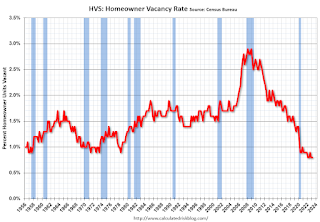 The HVS homeowner vacancy was unchanged at 0.8% in Q1 from 0.8% in Q4.
The HVS homeowner vacancy was unchanged at 0.8% in Q1 from 0.8% in Q4. Once again - this probably shows the general trend, but I wouldn't rely on the absolute numbers.


